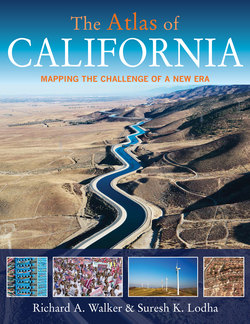Читать книгу The Atlas of California - Suresh K. Lodha - Страница 9
На сайте Литреса книга снята с продажи.
ОглавлениеIn this atlas, we eschew the usual myths for a more hard-nosed look at the Golden State, its successes and failures, its past and present, its human and natural contours. The real building blocks of California’s success have been the wealth of nature, an abundance of labor, and economic innovation, backed by a strong measure of good government. California has had the great luck, owing to its physical geography, to be sitting on mountains of gold and silver, great pools of oil, fast-moving rivers, thick forests, and some of the best farmland on earth—not to mention a favorable climate for growing things. The Gold Rush myth rests on this natural abundance, which went far beyond placer deposits, and which ended up back in Sacramento and San Francisco where it could be spent and invested on industrial development and urban expansion. Neither Spanish padres nor Anglo health-seekers after the sun had much to do with the growth of Los Angeles: oil and citrus launched modern Southern California. Even movies and aircraft came later. California grew out of its land, first of all, as we note in Chapter 1. California has benefited equally from the wealth of labor it drew in, and the aspirations of this ever-plentiful stream of people have been key to the idea of the California Dream. And, yes, folks came here full of hope, but they also came bearing valuable skills and heads full of knowledge and new ideas. Their payoff was good, too, and not just for the winners and stars. Coming to the Golden State worked out well for millions of the ordinary folk who built the cities and farms, laid down roads and levees, and manufactured cars and tractors. Yes, there were geniuses like Lee DeForest and Steve Jobs, but most people contributed by hard work, an improvement here and there, and acting as part of teams with collective dreams. Hence, Chapter 1 shows the land filling with people, who came in waves that broke our California’s shores, creating an amazing diversity unlike anywhere in the USA or even the world. With them came a dream of a mingled humanity from every continent that continues to this day. California has also been one of the great economic success stories in human history, and it has grown by leaps and bounds. Success in a capitalist world economy is never a static thing; it demands endless self-renewal by companies, nations, and regions. This endless renewal and growth has been the third foundation of the California Dream. The wealth of labor had to be put to work: producing more output, creating and using new machines, developing new industries, planting and processing new kinds of crops, designing and building new highways and houses, and more. Chapter 3 provides some windows on this process. California has been a technological hot-house. The developments here of pumps, nozzles, drills, and more, revolutionized global mining in the 19th century and later the oil industry. The state also invented modern agribusiness, based on food processing, massive dams, and modern fertilizers. It became an industrial powerhouse, surpassing the Midwest as the frontier of American genius, just as the latter had previously surpassed New England. Hollywood created new cameras, color film and sound, as well as the studio and star systems. LA aircraft companies designed single-wing planes, jet engines and mass assembly. Bay Area inventors came up with the vacuum tube, loudspeaker and television—all long before Silicon Valley. New things introduced in California have spread far and wide, changing the world. Some of these are everyday tools like the computer mouse and windows invented in Palo Alto, or the Google search engine, brain child of two Stanford students. Some are closely identified with California, like the fiberglass surfboard, while others, like the Zamboni ice resurfacer, are a surprise. Some are high tech, such as guidance systems for NASA rockets, while others are cultural, such as the Berkeley coffee-bar model copied by Starbucks. The economic fertility of California is not principally a matter of soil or sunshine, but of cities. California is a highly urbanized state and cities are the principal arenas of economic growth in the modern era. Cities are where capital, labor, and trade are concentrated,
10
